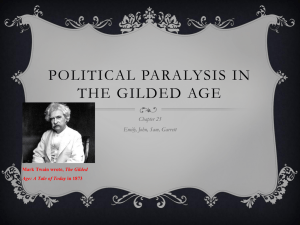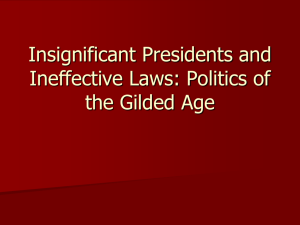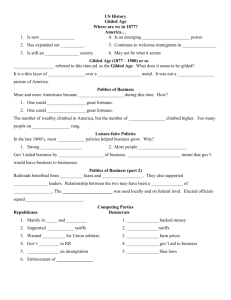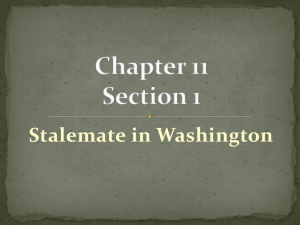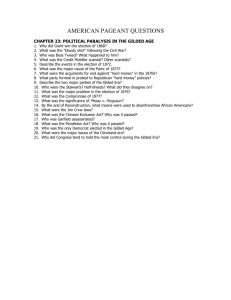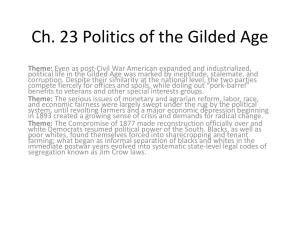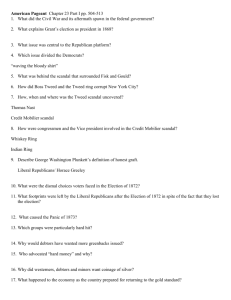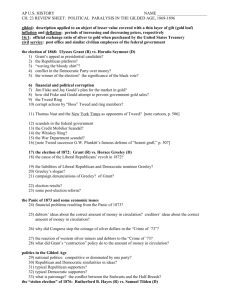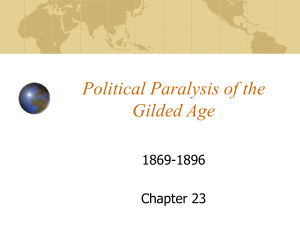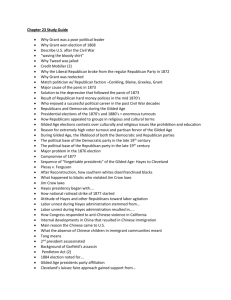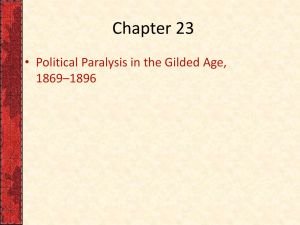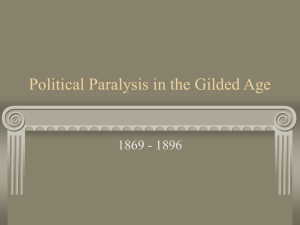Politics in the Gilded Age
advertisement
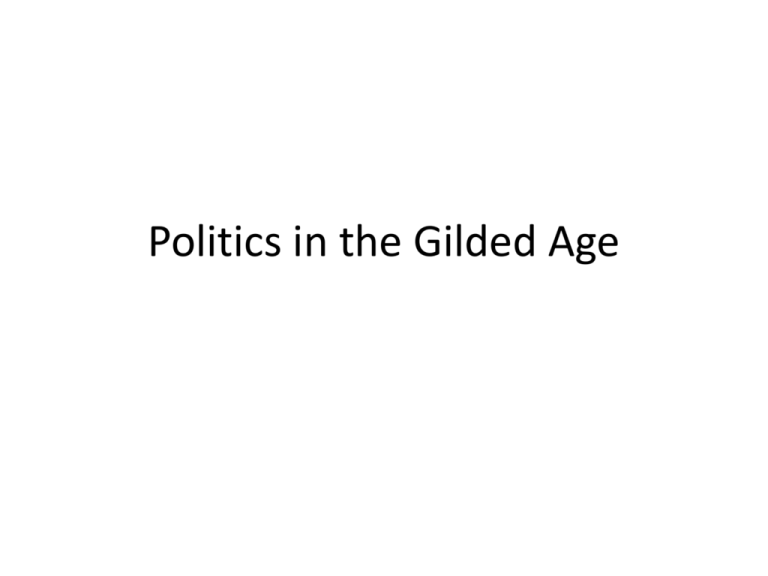
Politics in the Gilded Age Gilded Age 1865-1900 -Dates are not formal. The Gilded Age is usually considered to be from the end of the Civil War to the turn of the century -1900 usually marks the beginning of the Progressive Era -The developments that defined the Gilded Age continued after 1900 The name came from the title of a book by Mark Twain and Charles Dudley Warner: The Gilded Age, published in 1873 Gilded Age Politics • Republican dominance of the Presidency – All Republican presidents (except Cleveland) • Southern state governments became Democratic • Corruption at all levels • Voter turnout was very high- close to 80% of eligible voters in presidential elections Election of 1868 Ulysses S. Grant (R) v. Horatio Seymour (D) Grant won 214-80 Popular vote was much closer (votes of newly enfranchised African Americans make the difference) Waving the “Bloody Shirt”- reviving memories of the Civil War to gain political support Scandals • Crédit Mobilier – Insiders gave stock to members of Congress to avoid investigation of the huge profits they were making from government subsidies for building the transcontinental railroad • “Jubilee Jim” Fisk and Jay Gould tried to corner the gold market • Whiskey Ring – Federal revenue agents conspired with the liquor industry to defraud the government of millions in taxes • Belknap scandal – Secretary of War Belknap was impeached for accepting bribes from companies that had licenses to trade on Native American reservations. He resigned. Boss Tweed • William Tweed was boss of the Democratic Party in NY City • The Tammany Hall machine controlled city politics • The Tweed Ring swindled $200 million from New York taxpayers before Tweed was exposed by The New York Times and Thomas Nast • Tweed was imprisoned. • Graft- the acquisition of gain (as money) in dishonest or questionable ways (MerriamWebster) Thomas Nast • Immigrant from Germany • Cartoonist for Harper’s Weekly • Popularizes the donkey and the elephant as the symbols for the Democratic and Republican parties • Introduces the modern image of Santa Claus p490 The Bosses of the Senate Joseph Kepler in Puck 1889 https://www.senate.gov/artandhistory/art/artifact/Ga_Cartoon/Ga_cartoon_38_00392.htm The Election of 1872 • Liberal Republicans nominated Horace Greeley (editor of the New York Tribune) • Democrats endorsed Greeley – Greeley blamed the South and Democrats for the Civil War but accepted the Democratic nomination • Republicans nominated Grant • Grant won 286-66 • The Republicans reacted to the Liberal Republican threat by passing a general amnesty act (removing political restrictions on some former Confederates, reducing high Civil War tariffs, and passing some civil service reform p491 Pallid Politics in the Gilded Age • Presidential elections were close • Between 1869 and 1891 the majority party in the House switched six times • Republicans and Democrats generally agreed on most issues (tariff, civil-service reform, and currency) • Ethnic and cultural differences divided the parties • Two parties were highly competitive • They were both well organized with fiercely loyal members- partisanship was very high • Straight ticket voting was common • Election day was like a social event with parades, marching bands, food • Patronage was used to maintain party loyalty http://www.pewresearch.org/fact-tank/2014/07/24/voter-turnout-always-drops-off-for-midterm-elections-but-why/ Republicans • Core of Republican strength came from men in business and the middle class; most were AngloSaxon Protestants • Beliefs can be traced back to Puritanism • Stressed personal morality and believed gov’t should play a role in regulating the economy and moral affairs of society • Political base was in the Midwest and rural and small-town Northeast • Supported pro-business economic program of high tariffs Republicans • 1870s- leadership of the Republicans moved away from the previous reformers to those who played the patronage game • Stalwarts – Led by Roscoe Conkling (U.S. Senator from NY) • Half-Breeds – Led by James G. Blaine (Congressman from Maine) Democrats • Immigrant Lutherans and Catholics played an important role in their strength • Generally believed in more religious toleration and did not believe that government should impose a single moral standard on society • Electoral base was in the South and in the cities • Neither the Republicans nor the Democrats had a strong legislative agenda. • Politics in this era has been characterized by patronage and the objective of winning elections in order to provide jobs to the party faithful • At the local level, issues such as prohibition and education were important p493 The Election of 1876 Rutherford B. Hayes (R) vs. Samuel Tilden (D) • Tilden received 184 electoral votes of the 185 needed • Four states- Oregon, Louisiana, SC and Floridawere in dispute Compromise of 1877 • An electoral commission was established consisting of fifteen members selected from the Senate, the House and the Supreme Court to count the votes • As part of the compromise, it was agreed that Hayes could take office in return for withdrawing federal troops from Louisiana and South Carolina (the two states in which the troops remained) Map 23-1 p494 The Election of 1880 James A. Garfield (R) vs. Winfield Scott Hancock (D) Garfield won 214-155 • 1881 Garfield was assassinated by Charles J. Guiteau (who declared himself a Stalwart) • Chester A. Arthur (a Stalwart) became President – Ended up being more reformist than expected p499 Figure 23-1 p502 Pendleton Act 1883 • Garfield’s assassination helped push politicians to reform the civil-service system • Compulsory campaign contributions from federal employees were made illegal • The Civil Service Commission was established to make appointments to federal jobs on the basis of competitive examinations • Civil-service reform and the decline of patronage resulted in politicians looking to big business for campaign contributions • Mobilization of voters by party bosses gave way to raising money from manufacturers and lobbyists The Election of 1884 James G. Blaine (R) vs. Grover Cleveland (D) “Mugwumps”- reformers who did not want Blaine because he was tainted with corruption bolted the party Cleveland won 219-182 (NY proved to be the difference) Neither Blaine nor Cleveland had served in the war p502 “Old Grover” Takes Over • Uses patronage • Signs a tariff law that expands the tariff • Signs the Interstate Commerce Act The Election of 1888 Grover Cleveland (D) vs. Benjamin Harrison (R) (Grandson of William Henry Harrison) • The tariff issue divided the two partiesDemocrats want to lower it while Republicans wanted to keep it • Republicans raised $3 million • Harrison won 233-168 • Pro-business policies – Signs Sherman Antitrust Act • First “Billion dollar Congress” The Election of 1892 Cleveland (D) vs. Harrison (R) vs. Weaver (Populist) Cleveland won (the only President reelected after being defeated) Map 23-3 p507 • Cleveland signs Dawes Act – drastically changing the legal status of Native Americans – Makes Native Americans individual land holders on reservation lands • The Panic of 1893 turns into a long depression • The Pullman Strike is ended with use of the U.S. Army p511
